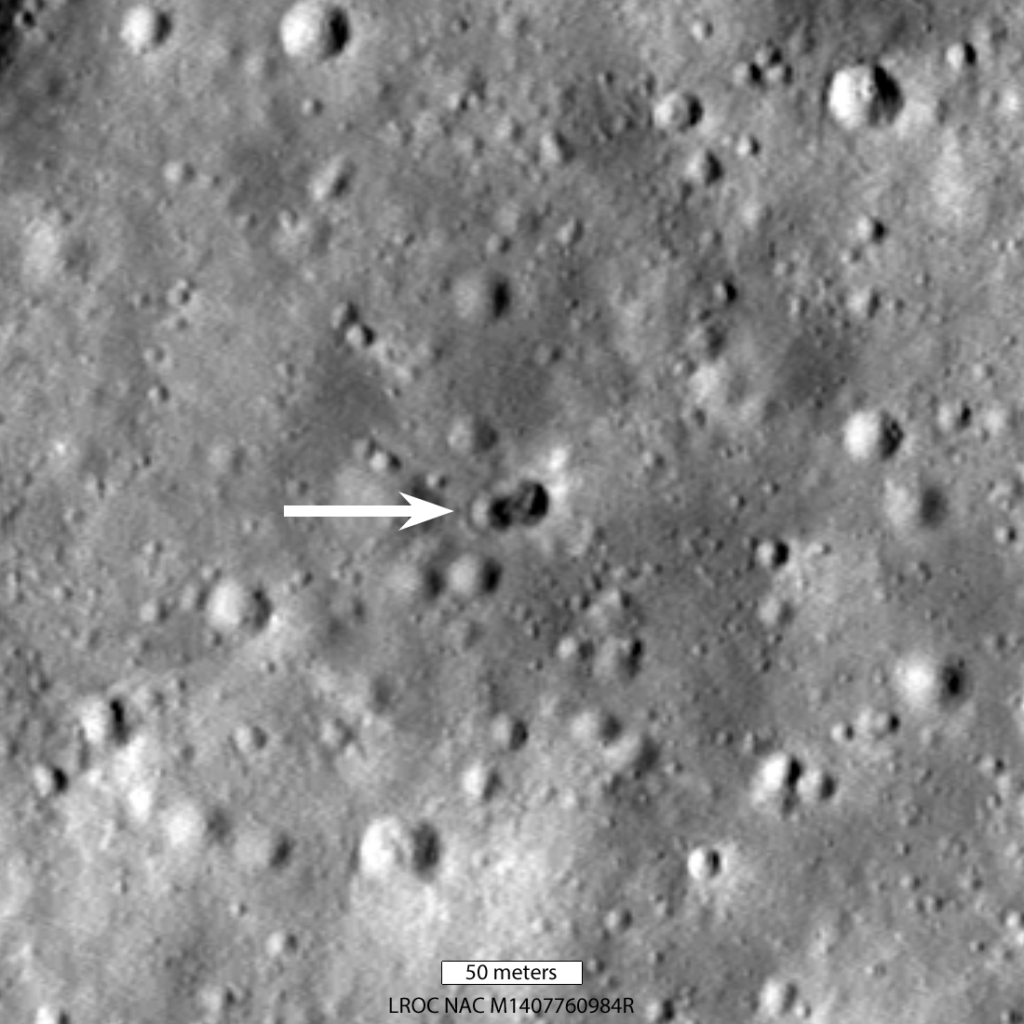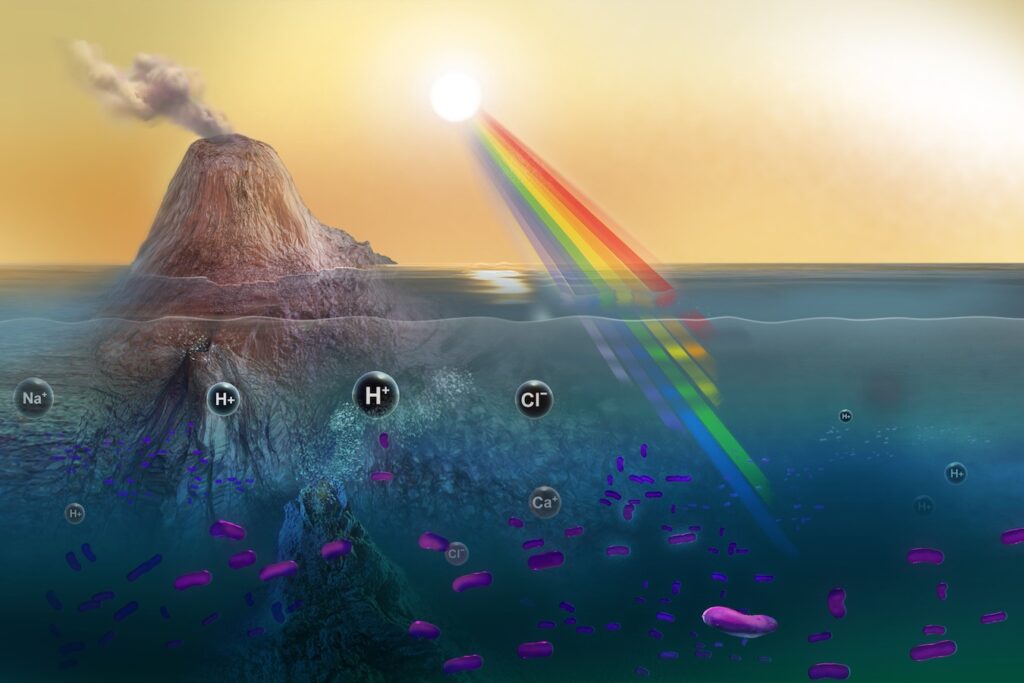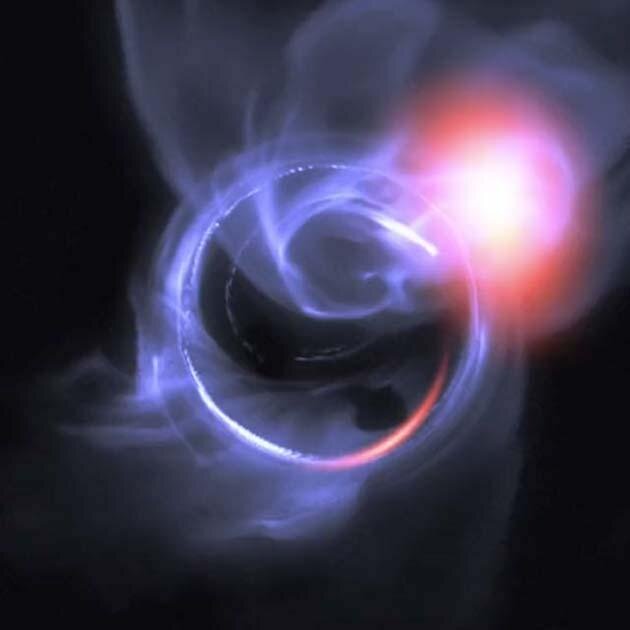With a little bit of luck and a lot of time on different telescopes, researchers managed to capture the black hole in the center of the Milky Way, SgrA*, consuming matter at a faster rate than usual. Plus, Australia launches a rocket, a couple of Mars stories, and strange glaciers on Earth.
Podcast
Show Notes
NASA launches rocket from Australia
- NASA press release
- NASA Conducting Suborbital Rocket Missions in Australia in June and July 2022 (NASA)
NASA’s mission to Psyche now launching in 2023
- NASA press release
Rocket News week of 6/27/22
- NASA’s Lunar Reconnaissance Orbiter Spots Rocket Impact Site on Moon (NASA)
- CASC press release (Chinese)
Mars fans wave toward past water flows
- PSI press release
- “The global distribution and morphologic characteristics of fan-shaped sedimentary landforms on Mars,” Alexander M. Morgan, Sharon A. Wilson, and Alan D. Howard, 2022 June 23, Icarus
Scary red ice is just chemistry in action
- PSI press release
- “A Multi-Technique Analysis of Surface Materials From Blood Falls, Antarctica,” Elizabeth C. Sklute et al., 2022 May 30, Frontiers in Astronomy and Space Sciences
Ancient microbes hint at possibilities for other worlds
- UCR press release
- “Earliest Photic Zone Niches Probed by Ancestral Microbial Rhodopsins,” Cathryn D. Sephus et al., 2022 May 7, Molecular Biology and Evolution
Black hole caught eating faster than normal
- CfA press release
- “Multiwavelength Variability of Sagittarius A* in 2019 July,” H. Boyce et al., 2022 May 18, The Astrophysical Journal
JWST’s NRISS ready for science
Transcript
A whole new continent launched into space for the first time this year today. The rocks stayed on the ground though. Just a sounding rocket.
Australia? They finally did it? That is awesome.
And we have more stuff about Mars water. And Earth water that’s more than a little rusty
We do. And about microbes that may or may not have lived in that water.
But definitely did not make glaciers look like the blood that was the iron.
And black holes.
And finally another update on That Telescope.
All that and more, right here on the Daily Space.
I am your host Dr. Pamela Gay.
I am your host Erik Madaus.
And we’re here to put science in your brain.

On June 26, a fairly normal Black Brant IX sounding rocket launched, carrying a payload studying X-ray sources to learn how galaxies and the stars in them evolved. Those targets, and indeed the launch site for the sounding rocket, were anything but normal, Australia. Launching from the southern hemisphere gives scientists access to parts of the sky they cannot reach from the usual launch sites in the United States.
Another milestone of this mission, the first of three which will go from the launch pad, is that it is run by a commercial company, Equatorial Launch Australia. NASA has previously launched sounding rockets from Australia, but those were done from the Australian Air Force’s Woomera Range Complex. Plans for the ELA site started in 2015 to bring economic investment to the area. The pad is quite hard to get to, over a day’s drive from Darwin, the largest city in the Northern Territory. The rocket stages had to be brought over water by barge.
The X-ray Quantum Calorimeter payload studied Alpha Centauri A and B, two of the closest stars to the Sun. In particle physics, a calorimeter measures the energy of particles. Just as this isn’t NASA’s first sounding rocket from Australia, this isn’t XQC’s first time in space. It flew into space 6 times from 1995 to 2013. It will tell a team from the University of Wisconsin the origin of a particularly bright patch of X-ray light. This patch is not visible from the northern hemisphere. The X-rays come from either type Ia or type II supernovae. Being able to distinguish the X-rays from these two sources will tell scientists about how the galaxy evolved because type II supernovae come from much younger stars than Ia.
The second of three sounding rockets from Australia this summer will also study Alpha Centauri A and B but in ultraviolet light, not X-ray. The third mission also studies ultraviolet light, but in a new band that hasn’t been studied too much.

Recently we talked about some observations of the asteroid Psyche by the Atacama Large Millimeter/submillimeter Array (ALMA) telescope in Chile. In the segment, we said that Psyche would launch in 2022. In a June 24 press conference, NASA said that would no longer be possible and that it would launch in 2023 or 24, arriving at the asteroid in 2029, not 2026. The cause of the delay is the flight software testing simulator. It was supposed to be delivered earlier in the year but was delayed.
After it was delivered, there was a problem with the simulator, which took time to fix. The launch was delayed at first from August to September to give teams time to fix the issue and test the software. The launch window for this year extended to October 11. This software is really important; it controls the spacecraft so that it can point its solar panels at the sun and its antenna at Earth. With the extra time, the simulator was fixed, but there wasn’t enough time to actually test the software. Ensuring it works is not something to do in a rush.
The delay will have more effects beyond simply causing three more years of flight time.
Several missions were planning on riding on the same rocket as Psyche — a pair of CubeSats to Mars and one to solar orbit carrying an atomic clock. These will need a different ride to space now. NASA is also reconsidering the mission itself. Discovery Program missions are cost limited for their entire lifetimes, and Psyche has used a significant amount of its cap so far. NASA is looking at Psyche’s place in the Discovery Program, and a decision on whether to continue it for the 2023 window or do something else will be decided in a few months. The spacecraft itself is fully assembled and ready to go.
To wrap up this rocket segment, an update on a past rocket story and the latest rocket launches.
But first, Rocket Lab launched the CAPSTONE mission for NASA this morning. The launch was successful, and the spacecraft is headed toward the Moon. We’ll have a full report on it tomorrow.

Speaking of the Moon, a few months ago, the space community caught the attention of a rocket stage heading towards the moon to impact. It was first thought to be from the Falcon 9 that launched DSCOVR, but then the person who made the initial prediction realized that was impossible, and it was actually from a Long March 3C that launched Chang’e-5 T1.
At the time, we said NASA’s Lunar Reconnaissance Orbiter would eventually spot it and take pictures of the crater. That has now happened, and the results are fascinating. Instead of one crater, it’s two very close together. This could identify which stage produced it, as most rocket stages have their masses at one end or the other. The crater is located in the larger crater Hertsprung, named after the Danish astronomer. Hertsprung crater is on the lunar far side.
Also, on June 27 at 15:46 UTC, a Chinese Long March 4C launched the Gaofen 12-03 satellite into orbit from the Jiuquan Satellite Launch Center in China. Gaofen 12-03 is a microwave radar remote sensing satellite that will be used by the Chinese government for high-resolution Earth observation. The press release didn’t mention specific uses for this capability, only saying the same things they say for nearly every satellite — urban planning, crop yield estimation, disaster prevention, and mitigation.
We can’t go a week without having some new research on Mars water. This fervor of news is largely associated with our desperate desire to understand “when was there water?” and “could it have allowed life to form?”
We know there was water. Mars is littered with water-formed features, ranging from lake beds to carved-out river valleys, and even the fan-shaped formations from where rivers emptied into oceans, plains, or lakes.

In a pair of new papers led by Alex Morgan and Edwine Kite that appear in Icarus and Science Advances, researchers look at both where fan-shaped features exist on Mars and when they existed. These observations were then compared to climate models to see if they can be used to predict how Mars’s temperatures and water changed over time.
According to Morgan: We’ve known for decades that Mars had rivers and lakes around 3.5 billion years ago, but in the past few years there has been a growing body of evidence that substantial amounts of liquid water continued to erode the Martian surface for hundreds of millions of years. The global distribution and morphologic characteristics of fan-shaped sedimentary landforms on Mars. Water-formed landforms, such as river deltas and alluvial fans, are the most unambiguous markers of past climate. So we conducted a global survey for these features and explored patterns in their distribution and morphologic properties.
Alluvial is a fancy word to say “formed by fluids.”
In their studies, the research team found more fans more recently at mid-latitudes. This means that while water flowed over much of the world in the past, it flowed for a longer period of time in the warmer areas nearer the equator. Morgan goes on to explain: We used a climate model to examine what the climate was like during these two eras of Mars’ early history and compared model results to the distribution of valley networks, which date to the earlier era, and alluvial fans, which date to the later era. We found that even though Mars cooled over time, from globally average temperatures of at least 25 degrees Fahrenheit to about 5 degrees Fahrenheit, liquid water continued to be stable in select areas.
They find water may have flowed as recently as 2.5 to 3 billion years ago. At that time, Earth did have life, just not multicellular life, so while I still look forward to fossil hunting on Mars, don’t go expecting fossils that are too complex.

As we try and understand Mars, we often find ourselves studying extreme environments here on Earth that may hint at what may one day be found on the red planet. And one of the most extreme things we find in the extreme environments of Antarctica are the Blood Falls. These highly disturbing-looking features on glaciers occur where salty water from deep in the ice escapes out through the surface and deposits materials from those pockets of liquid onto the surface of the ice. It’s thought those liquid pockets may contain life, and this raises the question “is that life making the gruesomely colored ice?”
Researchers led by Elizabeth Sklute have published a new paper in Frontiers in Astronomy and Space Science that says nope; it’s just rust. Which is a bit of a relief really. The idea that life happily living in the ice was dying on the surface and making blood-colored grossness… I didn’t like that, and this is where I remind you, I’m an astronomer, and when stars die, it isn’t gross stinky — it is just dramatic.
Anyway, that red color? That is rust. In the salty fluid coming out are various minerals that contain iron, and when iron is exposed to the air, you get rust. Rust like we see just about everywhere on the red planet. According to Sklute, the kind of iron minerals they are finding “have been found to be ubiquitous in Gale Crater on Mars by the Curiosity rover … Finding what may be similar material in a natural environment on Earth is really exciting.”
While Antarctica’s Blood Falls aren’t actually caused by blood or even life, life on Earth does actually help inform our understanding of Mars. Researchers study ancient microbes to try and understand what could exist in the cold waters of icy moons and in the history of formerly wet worlds like Mars.
And they aren’t using fossils.

Modern-day rhodopsins are the descendants of some of the most ancient lifeforms on Earth, and by looking at the genetics of rhodopsins, researchers can tease out the genetics of their ancestors. As described by researcher Edward Schwieterman: It’s like taking the DNA of many grandchildren to reproduce the DNA of their grandparents. Only, it’s not grandparents, but tiny things that lived billions of years ago, all over the world.
In a new paper in Molecular Biology and Evolution, researchers led by Cathryn Sephus detail how different kinds of life used different colors of sunlight to generate energy, allowing them to coexist in the same niche in the environment. Schwieterman adds: This suggests co-evolution, in that one group of organisms is exploiting light not absorbed by the other.
And because we have the ability to assemble tiny life from scratch, folks are now looking to recreate those grandparent lifeforms. According to Kacar: We engineer the ancient DNA inside modern genomes and reprogram the bugs to behave how we believe they did millions of years ago. Rhodopsin is a great candidate for laboratory time-travel studies.
This research has a lot of ethical issues and really seems like a solid target for science fiction writers. This is your reminder that all because science can do something, we need to ask ourselves should we.
Let’s switch topics and look at things with fewer implications to life as we know it — black holes feeding.

Astronomy is hard for a lot of reasons. There’s the maths and computer science needed to transform data into information. There is all the stuff you need to know so you know which maths and which software to use, and then there is stupid stuff like how big the sky is and how little of it is being watched at any given moment. Your typical telescope can view an area no larger than your pinky fingernail at arm’s length. That’s not a lot of sky, and given there just aren’t a lot of professional observatories in the world, most of the sky goes unmonitored most of the time.
It is often entirely by luck that we’re able to capture amazing things that happen in detail. Well, a lot of luck coupled with hard work.
Back in 2019, a team of astronomers applied for coordinated time using the Chandra, NuSTAR, ALMA, and VLT telescopes to observe the supermassive black hole Sgr A* in the center of our galaxy. This is a competitive process, and each telescope’s time has to be requested separately. To be able to get time on all these systems at once is pretty much as amazing as their science, which is pretty exciting.
It’s exciting because it appears that while they were observing Sgr A* with four amazing telescopes that span from X-ray to infrared and radio wavelengths, they caught Sgr A* in the act of potentially eating faster than normal. According to the research paper led by H Boyce and published in The Astrophysical Journal: A moderately bright NIR flare was captured on July 18 simultaneous with an X-ray flare that most likely preceded bright submillimeter flux.
Our black hole is always eating a little of this and a little of that. Dust, gas, random bits that don’t amount to a lot — it all adds up to just enough energy getting released as things scream toward the event horizon that the region around Sgr A* shines in colors of light our eyes can’t see, and the more it is eating, the more light is emitted.
And just to repeat myself — the light is coming from the material falling in, not from Sgr A* itself.
And each color of light comes from different, interrelated mechanisms. By seeing how light, or radiation, of different colors peaks in time with different effects happening simultaneously or with various delays, it’s possible to untangle the mechanisms behind each brightening and fading change in flux. This paper was able to identify three possible scenarios to explain what was seen, and future observations should allow us to narrow things down further.
As the researchers say in their summary: Narrowing down the radiation mechanism powering and connecting variability across wavelength regimes brings the field closer to accurately describing the physical mechanisms that power the dramatic flux changes originating near the event horizon.
This team worked hard and was awarded time on an amazing suite of telescopes. They got lucky and they were able to be on target when the black hole took a big bite of something. And because they worked hard and got lucky, we now know more than we knew before.
And next time a team like Boyce’s is able to get multi-telescope observing time, they just might be able to use the JWST.
In two weeks, we expect to get the first science images from this many-meter space telescope. We’ll be providing live coverage on our Twitch channel as it happens, and then covering it here on NowMedia. Any normal summer, we would go into our summer hiatus during the Fourth of July week and then come back the week of Labor Day. This year, we’re hanging on for that July 12 release, and our last day of the season will be July 15, and when we come back, it will be with a special episode on JWST’s results over the summer.

For now, all we can say is images are coming, and as of June 27, NASA had confirmed one more of JWST’s instruments is ready to start work. The Near-Infrared Imager and Slitless Spectrograph instrument, or NIRISS, has returned test data showing it can focus the light of a single object through a spectrograph to spread that light out into detailed rainbows that can be used to study how light is being emitted and absorbed by different atoms in different colors. This is about the ugliest telescope data you can look at, but it is how we may one day figure out the expansion of our universe and the compositions of different planets’ atmospheres.
Now to wait for those first images – or spectra – that will tell us just what this many billion-dollar, decade-delayed telescope can actually do. Things are looking promising.
This has been the Daily Space.
You can find more information on all our stories, including images, at DailySpace.org. As always, we’re here thanks to the donations of people like you. If you like our content, please consider joining our Patreon at Patreon.com/CosmoQuestX.
Credits
Written by Pamela Gay, Beth Johnson, Erik Madaus, and Gordon Dewis
Hosted by Pamela Gay, Beth Johnson, and Erik Madaus
Audio and Video Editing by Ally Pelphrey
Content Editing by Beth Johnson
Intro and Outro music by Kevin MacLeod, https://incompetech.com/music/


 We record most shows live, on Twitch. Follow us today to get alerts when we go live.
We record most shows live, on Twitch. Follow us today to get alerts when we go live.